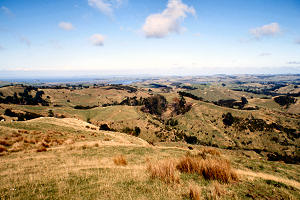
|
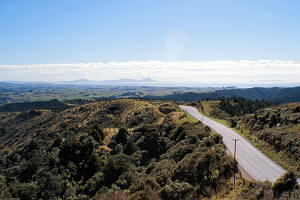
|
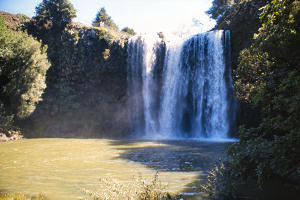
|
| Kaipara Harbour |
Bream Head across the Waipu Plain | Whangarei Falls |
Tuesday 15 March — Auckland to Kerikeri (293km) via the Bay of Islands
Well, a beautiful morning again. Al went off to work and returned five minutes later with a flat tyre. He opened his boot with difficulty and a screwdriver and we needed my wheel brace to shift the nuts on the wheel.
Off he went again and I went off up through Helensville and by the Kaipara Harbour to Wellsford, then up SH1 to Kawakawa for lunch (beer). No sign of the Bay of Islands Scenic Rail train so I went to Opua and discovered that they only run Friday to Monday at this time of year. However, Gabriel was sitting on the tracks so I took a photo anyway.

|

|

|
| Kaipara Harbour |
Bream Head across the Waipu Plain | Whangarei Falls |
On to Waitangi where there is a boat that I didn’t visit last time, but I decided that $4 to see a collection of shipwreck artefacts was a bit much so I passed it by this time as well. Sat around for a bit tidying the car and then had a snack in Paihia before drifting out via some local scenic attractions to Kerikeri where I booked into the hostel for one night.
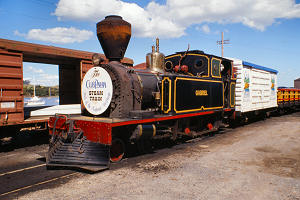
|
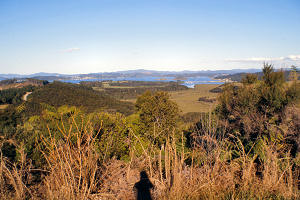
|
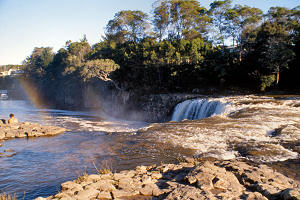
|
| Gabriel |
Waitangi & the Bay of Islands | Haruru Falls near Waitangi |
Wednesday 16 March — Kerikeri to Kaitia (160km)
Some cloud but mainly sunny in the morning. I drifted down to the Stone Store, the oldest stone-built building in New Zealand, started in 1833 and finished in 1835, that’s five years before the Treaty of Waitangi. It stands beside Kemp’s House, the first Pakeha house (as opposed to a temporary shack) in New Zealand. Thence to Rewa’s Village across the road, a reconstruction of a Maori village.
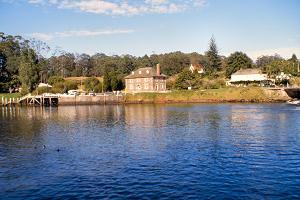
|
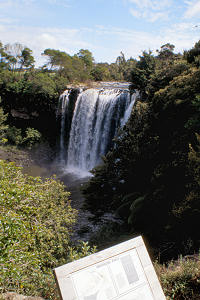
|
| The Stone Store |
Rainbow Falls near Kerikeri |
After leaving Kerikeri, I visited the Rainbow Falls but the sun was in the wrong place and there were no rainbows. Mind you, I’ve seen some nice rainbows at other falls I’ve visited in the last few days. I picked up SH1 again and proceeded to Kaeo and the Whangaroa Harbour where I ascended to the top of St Paul’s Rock, an outcrop which sticks up incongruously on the ridge above Whangaroa village, affording excellent views of the Harbour.
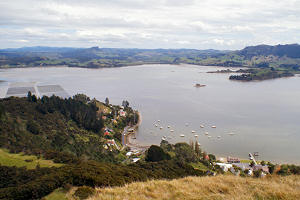
|
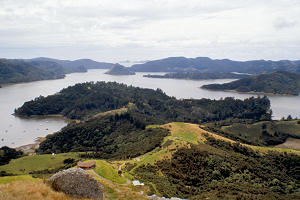
|
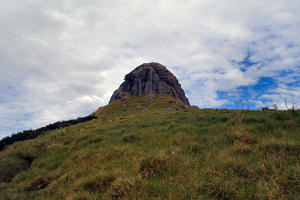
|
| |
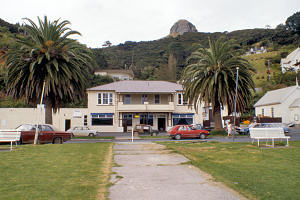
|
| Hotel Marlin |
Then through Mangonui and Cooper’s Beach to Awanui where the road turns south to Kaitia, but I turned north for the few kilometres to the Waipapakauri Hotel for a refreshment. Then back through Kaitia to Ahupira, the southern end of Ninety Mile Beach. This is a misnomer as it is only sixty kilometres long, but still some beach. Not that I’m much impressed by beaches anyway. Returned to Kaitia to the YH and booked in for two nights, and booked Rob’s Far North Magic Tour to Cape Reinga for the morrow.
Thursday 17 March — Cape Reinga
There was no sign of the forecast rain in the morning. There were five of us from the YH and the driver, Rob himself, on the tour to Cape Reinga. The tour did not start from Kaitia itself as there is a limit of 100 kilometres each way on tours using four wheel drive vehicles and it is 107 kilometres from Kaitia to the Cape. However, Rob lives in Kaitia and is quite happy to give folk a lift for the first eight kilometres out of Kaitia to the farm shop where the tour officially starts.
The direction of the tour varies according to the state of the tides on Ninety Mile Beach and today it went up the main road, stopping for a bit at Rawara Beach, where the white sands are commercially exploited for glass-making, but not locally. Then up to the Cape, a walk along to the lighthouse and a bit downhill towards the sacred pohutukawa tree, but not too far as I couldn’t be bothered with the walk back uphill, especially in jandals.
Maori legend has it that the souls of the dead travel, from wherever they may be in New Zealand, to Cape Reinga before descending to the underworld by climbing down the exposed roots of this pohutukawa tree.
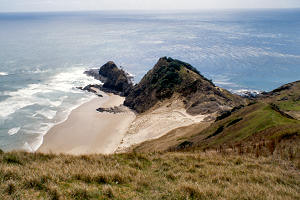
|
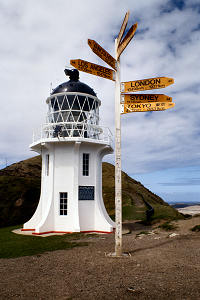
|
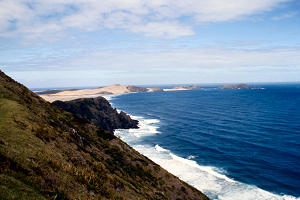
|
| Cape Reinga |
Lighthouse | Shoreline west of Cape Reinga |
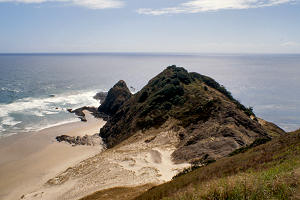
|
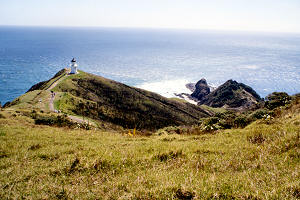
|
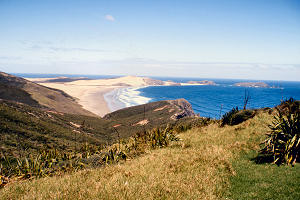
|
| |
Next we went to Tapatupotu Bay, not far away, for lunch (bring your own) and an optional swim (I didn’t) before driving down to Ninety Mile Beach via the Te Paki stream. The sand dunes here are immense and have been used by European film makers for the Sahara Desert! There were a couple of large tour buses around, apparently there is an unofficial convoy system as it is not unknown for buses to get bogged down in the sand, and then swamped when the tide comes in.
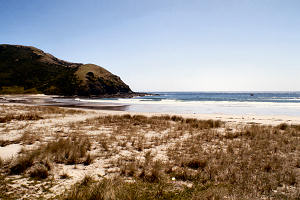
|
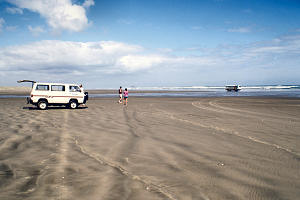
|
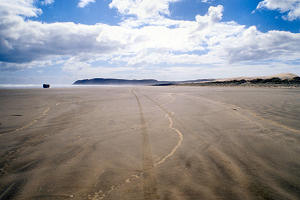
|
| Tapatupotu Bay |
On Ninety Mile Beach | |
Down the beach at speed (less chance of sinking) to a rocky outcrop known as The Bluff, the remains of a volcanic plug and the only thing to break the line of the beach, then a detour off the beach and up an overgrown sandhill called Hukatere Hill, which the large buses can’t get to, and from the top of which you can see, on a clear day, both ends of the beach. I doubt if there are many days when you can actually see very far along the beach as it it usually obscured by a mist drifting in off the surf, but we could see the headlands at either end.
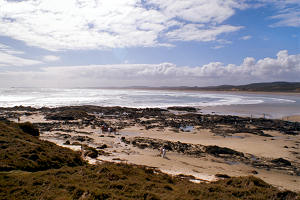
|
| North from The Bluff |
Then back to Kaitia. I went into a pub in the evening where they were serving (on request) green beer and various other green drinks. I did not try any. A few more beers in another pub where there was a darts match in progress then back to the hostel for what was left of the evening. There was a lad from Pennsylvania, a teacher, who kept his diary on airmail letter paper and sent the pages home every few days to his wife, who would have the whole thing on the word processor when he returned.
I arranged to take two lads, a German and a Canadian, down to Opononi in the morning, after I had been to the bank and the local museum.
Friday 18 March — Kaitai to Opononi (124km) via the Rawene Ferry
So I went to the bank and extracted some money, and then to the Far North Museum, which was quite interesting. Bits about kauri gum and early Maori settlement, of which there was a lot in this area, and Ninety Mile Beach was used as an airstrip for the first trans-Tasman crossings.
I picked up Carsten and Bruce at the hostel and we set off south by the back road heading for the Rawene Ferry. An uneventful run, the only excitement was watching a harrier fly into a telegraph wire and lose a few feathers. The ferry seems to have a front and back because, as soon as it left the slipway, it turned round and went backwards to Rawene, turning again just before it docked.
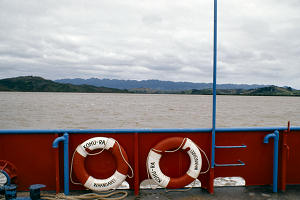
|
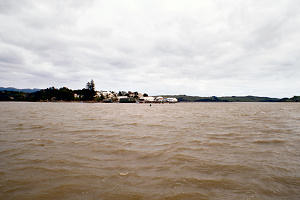
|
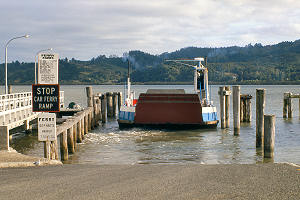
|
| Hokianga Harbour |
Approaching Rawene | The ferry at Rawene in January |
And so to Opononi. Carsten and Bruce decided to stay at Harmony House, the Backpacker hostel in Opononi so I dropped them and their gear there and went for a beer or two until it was a respectable hour to go to the YH. When I got there, there was Carsten before me. He had decided that he didn’t like the ambience in Harmony House and had walked the couple of kilometres up the road while I was in the pub.
The hostel is a converted school, two classrooms providing the male and female dormitories with possibly two rooms knocked together to form the kitchen and common room. Showers have been installed in the cloakrooms, the staffroom is the warden’s dayroom and the book store is the office. The wardens, Ewan and Marta, live in a caravan outside, although there is talk of building permanent warden’s accommodation.
After a bite to eat, I walked back down into Opononi to see what the Hokianga Folk Club had to offer. I arrived late and left early. It was a bit of a mutual admiration society, musically competent but with a bit too much of songs and poems that they had written themselves.
As I walked back up the road, a car stopped. “Is that you Jeff?” “No” I replied. “Who are you?” asked the driver. “A total stranger” I said. “Oh!” and the car drove off. I didn’t fall in any ditches.
Saturday 19 March— Opononi (34km)
I was awakened at 0610 (I looked at my watch) by a drumming of rain on the roof. I thought of getting up to have a look but decided against it and went back to sleep. When I did get up, late at half past eight, it was sunny. Carsten said that he usually woke at seven but had slept till after eight because it was so quiet here. He hadn’t heard the rain.
It was actually a mixed morning, quite a lot of cloud with some sunny patches. With nothing better to do, I pottered around till well after ten before setting off up the road for a walk on the Waiotemarama Bush Walk. Some fine kauri trees, including one oozing gum that looked like candle-grease. I walked till I got bored and then back to the car to drive down for a walk on Waimamuka Beach, or at least that’s what the signpost called it. However, it is called Kaikai Beach on the map and there is a sign giving the quotas and legal sizes for pauas and other shellfish. (Kai means food.)
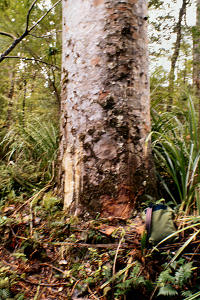
|
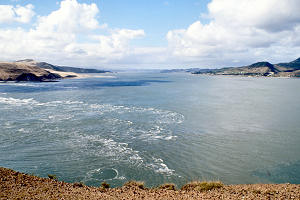
|
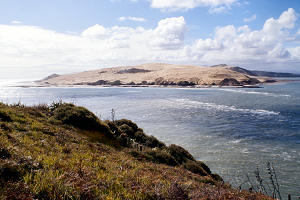
|
| Kauri gum |
Hokianga Harbour | North Head |
Up to the South Head at the entrance to the Hokianga Harbour to admire the view, then along to the pub. At the hostel, I thought I had the place to myself until a car turned up just before seven with three Canadians and a girl from Caithness. Could have been worse.
Sunday 20 March — Opononi to Whangarei (213km) via Dargaville
Well, I got up a bit earlier than yesterday and pottered about again till it was about nine when I set off south through the Waipoua Forest, which I visited in January. This time I went to see the Yakas Tree as well, a pleasant walk passing quite a lot of large kauri en route, including one stand labelled “Cathedral Grove”, very appropriate. I am still of the opinion that Te Matua Ngahere is the most impressive kauri around.
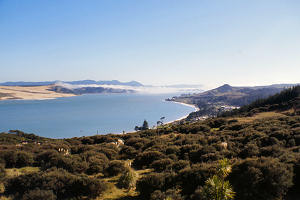
|
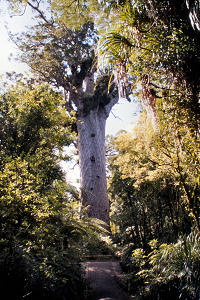
|
| Hokianga Harbour | Tane Mahupu (Lord of the Forest) |
I tried to get to Trounson Kauri Park but the road was closed just beyond Donnelly’s Crossing, the aftermath of Cyclone Bola, and I had to retrace my steps to the main road. Then a detour to the Kai Iwi Lakes, very nice but not spectacular. Then Dargaville for a late lunch, pie and chips. The Wairoa River was still pretty full and silt laden but they did restore the town water supply last week.
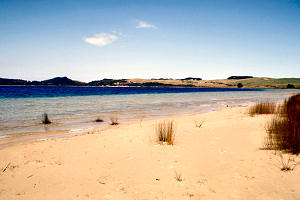
|
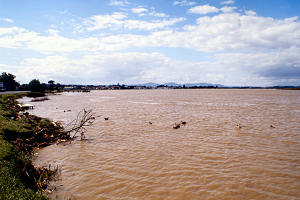
|
| Kai Iwi Lakes |
Dargaville by the river |
I did consider stopping at the hostel in Dargaville but it was still quite early in the afternoon so I continued across country towards Whangarei. After an uneventful journey, I wandered around a bit in the town and then booked into the hostel. I tried to sort out my itinerary for Australia, but gave up after a while and had a meaningful conversation with Sandy, the assistant warden. She, too, was much impressed by Te Matua Ngahere.
Monday 21 March — Whangarei (141km)
Having failed to sort out my Australian plans, I decided there was not much point in going back to Auckland today and I might as well hang around Whangarei and I set out to climb Mt Manaia, just before Bream Head out at the end of the Whangarei Harbour.
The track is described as “easy at first, steep later”, but the easy bit had suffered a fair amount of fallen trees in the storm and it was a tedious business climbing over, under, through and round the debris. The steep bit was a pleasure by comparison until I reached the pinnacles at the top, where I decided that discretion was the better part of stupidity. The ascent didn’t look particularly difficult, but I might have had problems getting back down so I threw in the towel.
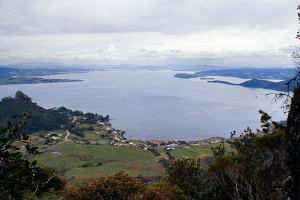
|
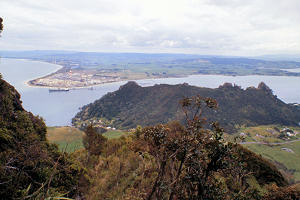
|
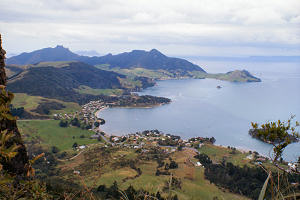
|
| Whangarei Harbour |
Marsden Point Refinery | Bream Head |
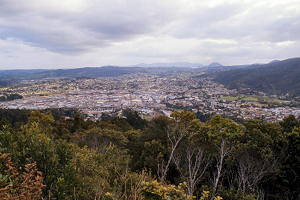
|
| Whangarei from Parahaki Summit |
After climbing over, under, through and round the fallen trees again on the way back down, I moved on to another scenic reserve but a brief shower dampened any enthusiasm I had left for walking and I frittered away the rest of the afternoon driving up the Tutakaka Coast a bit, admiring the bays, beaches and the view back down to Bream Head.
Back at the hostel, there were five soon-to-be school leavers from the Bay of Islands staying for a few days, prospecting for jobs with no real expectation of success, plus an Englishman, two Irish lassies and assorted North Americans, rather busier than the four folk that were in last night.
I was in no mood to wrestle with Australian rail timetables so I headed into town for a beer. I found a pleasant establishment where there was just myself and a group of locals. One of them, a large Maori looking lad, came over and brusquely demanded to know who I was and what I was doing. Then he said - “We don’t like people drinking on their own in here, it looks bad, please come over and join us.” I persuaded him I was quite happy on my own.
Back to the hostel to write this while consuming a pot of tea, then retired.
Tuesday 22 March — Whangarei to Auckland (263km)
A reasonably bright sort of morning. I set off in a leisurely manner back towards Auckland, detouring round by the refinery at Marsden Point but there was a boilermakers picket outside the main gate so I gave the Visitor Centre a miss. The view from One Tree Point across to Mt Manaia and Bream Head was quite good but the sun was in a bad position for photography.
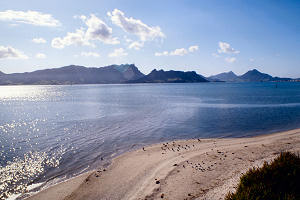
|
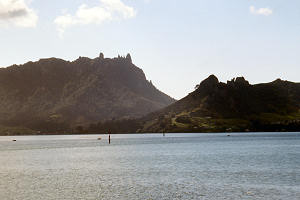
|
| Mt Manaia |
|
From Waipu, I took the coast road through Waipu Cove, Lang’s Beach and Mangawhai Heads before rejoining SH1 at Kaiwaka. Stopped at the Top of the Dome Tearoom between Wellsford and Warkworth for a late morning tea or early lunch but decided against visiting Sandspit as I had a few things to do in Auckland in the afternoon. A brief halt at Wenderholm Park to change into “city” clothes, denims and a shirt with pockets rather than shorts and T-shirt, and then on into the big smoke.
First stop the Australia Travel Shop where, to my considerable amazement they had confirmation of my reservation for the Sydney to Perth steam tour. NZ$1515, just like that, but I can afford it. A beer to celebrate then to the railway station to check various conditions on the Austrailpass. Up to AVTEC to collect seven processed slide films at $10.04 each. Found a car wash and got rid of the top layer of dirt on the car. Out to Henderson, beating Al in by two minutes. We didn’t do much with the evening apart from eat, drink, watch TV and fill in my tax return.
Wednesday 23 March — Auckland
This was meant to be a dynamic day, getting lots of things done, but although I was busy most of the day, there was not much to show for it at the end. The car looked a bit cleaner after I has spent an hour shifting the remaining mud off the wheel arches and other less accessible bits which had escaped the car wash, then emptied the ashtray and cleaned the interior. I had also done the laundry and that was about it. In the evening I finally sorted out an itinerary for the first month in Australia.
Thursday 24 March — Auckland
Well, that’s the end of the car era. I took it back to ICL via the car wash again, and was complimented on how clean it was. Apparently most people return cars in a disgusting condition. I didn’t mention that if the car had been going back to Giltrap, it would have been in a disgusting condition too. Had a chat with a few engineers and was given a bottle of Dimple.
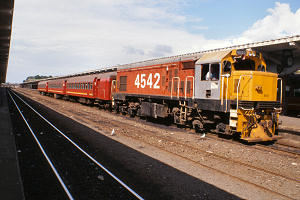
Suburban train
Then I set off, as I will have to continue, walking, back to town. To the photo shop to buy more film, to the tax office to settle up my income tax, to the pub for lunch then to the railway station to buy a 60 day Austrailpass and give in the list of reservations I want for the first month. Only to find that The Alice, from Sydney to Alice Springs has been withdrawn until further notice and I had to rework a week’s travel plan on the spot. Not an optimum solution but better than re-doing the whole month.
Took the train out to Sturges Road, one stop beyond Henderson and fifteen minutes walk from Al’s. After tea, I went to the pub on Lincoln Road with Al and Steve Watters. Claudia and Debbie arrived later, after doing their own things. The pub was a posh place, or trying to be, for the upwardly mobile. No jeans, I had to wear my trousers for the first time in months, but the bouncer had a friend in jeans and scruffy T-shirt who wandered in and out at will. Perhaps he was the owner. One group going into the restaurant were not allowed into the bar because some of them were wearing jeans. The beer was not cheap either, but we still managed a few.
It looks as if I will be able to manage all I need on my further NZ travels, in the rucksack, including sleeping bag but excluding boots. I hope that is not a mistake.
Friday 25 March — Auckland to Wellington (685km)
Al gave me a lift to the station, very slow along the North Western Motorway and we didn’t get to the station until quarter past eight. Luckily the train was not due to depart till half past.
The Silver Fern is a two-unit diesel railcar or perhaps that should be an articulated railcar as the engines are at one end occupying half of that unit. Three of them were built in Japan in 1972, one runs in each direction each day and one is spare. They do not run at weekends or on Bank Holidays so I hadn’t managed to fit in a trip on it before.
The trains are air conditioned with airline style interior, the seats are comfortable but a bit narrow, not surprising given the 3’6" gauge, all facing one way and apparently not reversible so they must turn the train at each end. The ticket includes a newspaper, morning and afternoon tea, and an airline style lunch was $12, all served at your seat. A drinks trolley came through several times but I didn’t buy anything - BR type prices e.g. $3 for a small tin of beer that costs a dollar from the bottle shop.
We left more or less on time and stayed that way until we were delayed ten minutes at Otorohanga for “yard shunting”. I did see the shunter but it seems odd to be using the main line for shunting when a through train is due. We stayed eight to ten minutes late down to Palmerston North but then recovered to be two minutes early at Wellington, or five minutes depending on which timetable you believe.
One of the crew gave a commentary as we ascended the Raurimu Spiral, pointing out where we had been, where we were going and where we were crossing over ourselves. We had run through a restricted speed section between Taumarunui and Taihape where the level of vibration and noise, despite the double glazing, was significantly worse than British Rail. On one long curve, I got the impression that they had laid short straight lengths of rail set at an angle at the joins. The north and southbound trains change crews in the middle of the Horopito Deviation and as we got there first, I was allowed out to take photographs of the trains.
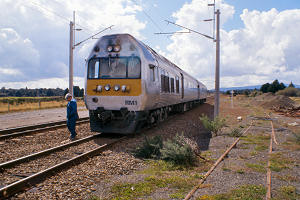
|
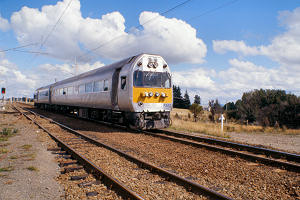
|
| Southbound | Northbound |
| (The overhead electrics are used by freight trains between
Palmerston North & Hamilton.) |
|
On arrival at Wellington, I decided to try the YH on the off-chance and lo, there were beds available for males. So I stayed there rather than disturb Dave and Anne (and William and Hannah) twice in four nights. A couple of beers in the Railway Tavern and early to bed.
Saturday 26 March — Wellington to Napier (321km)
Up early and drifted down to the station, expecting to see the Silver Fern leaving for Auckland. I was a bit surprised by its non-appearance until I realised what day it was. While I was waiting for the Gisborne Express, the Northerner arrived. This is the overnight service between Auckland and Wellington and used to have yellow coaches with leather seats three abreast with plenty of leg room. It also used to have sleepers but they were withdrawn last year (or was it the year before). What arrived now was a set of standard blue “intercity” coaches with four abreast and, I suspect, less leg room. I will be disappointed if that is what I get tomorrow night, on my way back from Hamilton.
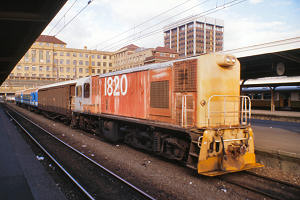
|
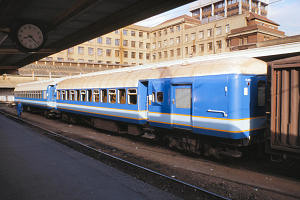
|
| Shunter brings in ... |
... the Gisborne Express carriages |
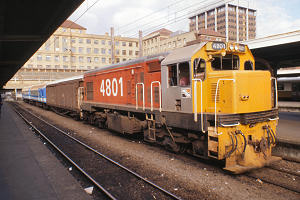
|
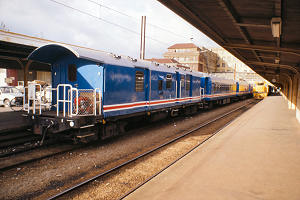
|
| Gisborne Express complete |
Northerner guard’s van |
So I boarded the Gisborne Express, which won’t get past Napier, as they have not yet re-instated the line beyond there, but that doesn’t matter as I’m only going to Napier anyway. Two blue coaches plus a parcels van for luggage and some parcels, loco hauled. (Everything in New Zealand is loco hauled except for the Silver Fern and the Wellington EMUs.)
Off we went, running on time as far as Paraparaumu where we were held up for ten minutes waiting to cross a southbound freight, and although we recovered the odd minute here and there, we also lost a few at the refreshment stop at Palmerston North and were about seven minutes late at Napier.
The run from Wellington is fairly interesting through the tunnels to Paekakariki, then very mundane to Palmerston North. Through the Manawatu Gorge is very interesting. From the train, the precarious perch of the road is very obvious across the river, both road and rail were about forty feet above the present water level. The run up the Wairarapa would have been boring, just pleasant, rolling pasture, except that every so often a small river would have cut an inordinately deep chasm for itself, which we crossed on high viaducts.
At Napier, the Gisborne passengers transferred to a bus. Earlier, I had heard the guard tell some other passengers that the return service would be running one hour later than timetabled from Napier to Wellington for the next eight weeks. I suspect that is to allow for what must still be a difficult bus journey between Gisborne and Napier, and is indicative of when they expect to reinstate the railway line.
I ambled down to the YH, a converted hotel on the promenade, where a notice said that there were plenty of beds so I dropped my pack and went for a beer, returning at five o’clock to book in and drink a pot of tea. I wasn’t carrying much food so I went off into town, thinking to feed on a burger and beer. However, there seemed to be nothing but junk food shops like Macdonalds in the centre of town and I walked some time before finding a proper fish and chip shop. Those New Zealand fish and chip shops which do burgers as well, do much better (and bigger) burgers than Macdonalds and such like places.
Sunday 27 March — Napier to Hamilton (300km)
Lots of late night revellers last night, including the occupants of the other two beds in my room, so I made no effort to be quiet when I got up at seven. A pot of tea and a couple of oaty bars for breakfast before going off to admire the view from Bluff Hill (there are a lot of Bluffs in New Zealand), the last of a line of small hills running out to the sea and probably instrumental in the formation of the large flat expanse of coastal plain on either side.
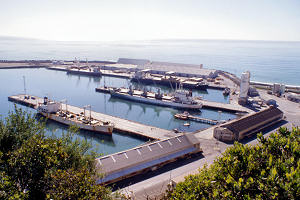
|
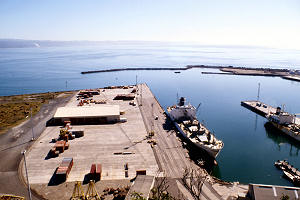
|
| Napier docks |
|
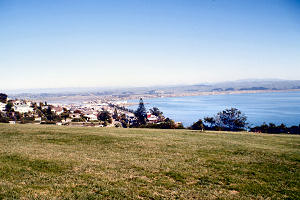
|
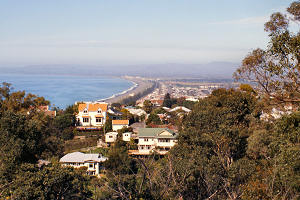
|
| North |
South |
Then by a switchback route to the Botanical Gardens on Hospital Hill, fourth from the end, which includes an aviary with numerous finches, budgies etc. and a few more interesting species. I ate an apple and gave the core to some sparrows, who soon lost interest in it so I retrieved it and offered it to some ducks who consumed it with apparent relish.
Back towards the town, the museum was not yet open so I went to the Nocturnal Animal House. As well as kiwis, they have moreporks, barn owls, some sort of nocturnal heron, possums, rats and other things. They were supposed to have snails as well but all I could see was shells, and there was no sign of the hedgehog either.
By this time the museum was open and I watched the audio visual presentation on the 1931 Hawkes Bay Earthquake in which most of the centre of Napier was demolished or burnt down (the quake destroyed the water supply) and over 250 people killed, then another on East Coast Maori tribes and generally wandered around a reasonable, small museum. The art gallery didn’t impress, but then not much modern art does.
A leisurely stroll back along the front to the YH to pick up my pack and wander along to the bus/railway station, just missing the departure of the train for Wellington but catching the last couple of sandwiches in the tearoom, though I did have to eat them and drink my tea on the platform while waiting for my bus.
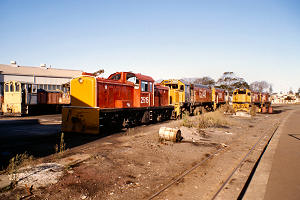
|
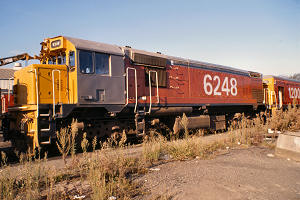
|
| Idle locos at Napier |
|
The bus to Hamilton (then Auckland) was the size of a 48-seater but had only twenty seats as the back of the bus was space for luggage and parcels. I got a window seat with no-one beside me until, as it grew dark, we arrived at Taupo. We lost half an hour there as the connecting service between Wellington and Rotorua was late. Down to twenty minutes late leaving Tokoroa but on time at Hamilton. According to my calculations, the bus driver averaged 110kph between Tirau and Cambridge, not bad in a country with an open road limit of 100kph.
The road from Napier up through Eskdale showed me for the first time some of the more serious signs of the aftermath of Cyclone Bola, several inches of silt on the fields up to about six feet above the current water level, in some places drifted like snow. Numerous small slips on the river banks and hillsides, and some large ones too.
At one point, there was a collection of graders and excavators which appeared to have been used to re-instate about fifty feet of a river which had filled with silt, elsewhere a temporary road had been built through the fields where three-quarters of the old road had slipped, not just a foot or two, but a couple of hundred feet, straight down, like the Devil’s Beeftub near Moffat.
At Hamilton, it was another bus with four passengers from the bus station to the railway station. The bus driver doubled as station master while we waited for the arrival of the train from Auckland, checking in the luggage, selling a few tickets and having a cup of tea.
The train arrived about five minutes late and I was not pleased. The Northerner is no more. Instead, we had the “inter-city” cattle trucks I had seen at Wellington a few days before. Cramped and uncomfortable, the seats did recline but they were narrow and had hard armrests. One of the three coaches had video but luckily not the one I was in. There was a small all-night buffet but the consumption of alcohol is forbidden so no nightcaps.
The carriage lights were switched out leaving the only illumination the glow through the glass panels in the end doors, but that was bright enough to be disturbing but not enough for reading, and there were no individual reading lights or ventilation. I had a double seat to myself but still could not get a comfortable position so slept very little, with frequent attacks of cramp. I might take a bus next time.
Monday 28 March — Hamilton to Wellington (630km)
The train ran about ten minutes late through the night. Half an hour before Palmerston North, I went for a cup of tea and a sandwich. There was no cheese!
Quite a few people besides myself got off at Palmerston North, where I had about half an hour to wait for the train to Wellington via Masterton, which turned out to be two red coaches and a parcels van. It was a good run through the Manawatu Gorge to Woodville then down the Wairarapa to Masterton. From there on, the train is really just a Wellington suburban express, stopping at main commuter stations and getting very full by the time it reaches the city.
I dumped my bag at the left luggage at the station, free for up to a week if you have a valid bus or train ticket, and went for a run on the suburban electric up to Johnsonville and back. This is the original start of the Wellington and Manawatu line and it was a brave man who picked that route, carved into the side of a steep valley with numerous tunnels and tight curves. The pylons supporting the overhead wires are at times only twenty-five feet part to accommodate the curves. About twenty-five minutes each way, eight stations, a dead end now.
Into the Waterloo Bar for a couple of jugs. This place was obviously the local watering hole for the wharfies. Then I bought a pair of cheap! trainers for $90 which would probable cost about £10 at home. We’ll see how long they last. I had a look at some travelling packs, if the New Zealand dollar continues to drop, I might spend $350 on one as they look to be a bit more convenient for the type of travelling I’m doing at the moment, and I could ship my Karrimor home with the stuff that I’m not taking to Australia. There is already enough of that to overflow my cases. I bought some dried fruit and nuts to replenish my stock of nibbles and returned to the station to recover my pack and book some buses for after I reach Invercargill next week.
After several attempts, I finally caught Anne at home on the phone, accepted her kind offer of a bed for the night and took the trolley bus up to Karori. It’s amazing the acceleration those buses can manage uphill, particularly when they are full of standing passengers on the way home from work.
I survived the energetic attentions of William and Hannah for the evening, had a meal, a shower and slept like a log. Renovations of the kitchen/family room are proceeding apace, there is even some paper on the walls.
[ next chapter ]
John Reynolds — March 2013